1625.—GRAMMAR SCHOOL
BUILT.—The Grammar School of the burgh,
which had been erected soon after the destruction of the
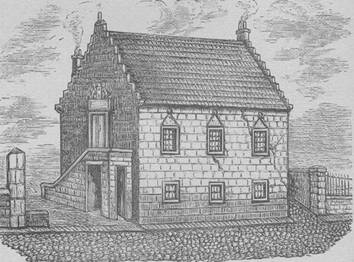
Abbey, by GED, was
enveloped in the flames of the great fire of 25th May,
1624, and reduced to a ruin. In 1625, a new school was erected on the
same site. The school of 1625 stood until 1817, in the S.E. corner of
the play-ground of the present school. It was a small building,
devoid of architectural adornment—about 40 feet in length, 25 in
breadth, and 16 in height. The preceding view of it was taken by the
writer from a much larger one in possession of Mr. Ramsay, London,
a son of the teacher who held the school
early in the present century.
The view is taken
from the south-west, apparently on the street, opposite Queen Ann
Street manse gate. The school consisted of two storeys, three windows
on the ground apartment, and three large ones above, facing the
street, where the business of the school was conducted, the entrance
into which was by an outside stair built to the east gable. Above the
door there was a large stone, having cut into it the Latin words—
FAVE MIHI MI DEUS 1625
That is—“Favour me,
O my God.” Above were the town’s arms—a tower with rampant lion
supporters, and 1625, the date of erection. On the triangular stones,
on the east and west, above the upper windows there were inscriptions;
the stone above the middle window was embellished with a large
thistle. On the stone above the west window were the Latin words,--
SEP:
DOCE ET
CASTIGA VT
VIVAT PVER
This is, “Often
teach and chastise, that the boy may live.” And on the stone above
the east window were, also in Latin, the words,--
X
DISCE
ET PATE=
RE SIC
TE BEAB=
IT DEUS TUUS
That is, “Learn and
suffer. Thus thy God shall bless thee.” The first inscription is a
general supplication for Divine aid; the second gives advice to the
teacher to give proper instruction and due chastisement; the third
gives advice to the scholars to learn with diligence and submit to
punishment and thus shall they receive the blessing of God.
This school of
1625 was long felt to be too small for the increasing population of
the burgh; it was removed in 1817, whilst the present more handsome
edifice was being erected. Mr. Archibald Haxton,
a most excellent teacher and disciplinarian, was the last of the many
teachers who, during 191 years, had done service in it. The writer
was a pupil for a short period before its removal. (See Annals, date
1816-17.)
PROVOST OF
DUNFERMLINE.—Thomas Wardlaw, of Logie.
1626.—MARKET
CROSS.—The first notice of a Market Cross in Dunfermline is to be
found under date 1499; but, although not mentioned, there would be one
as early as 1395, if not much earlier, for
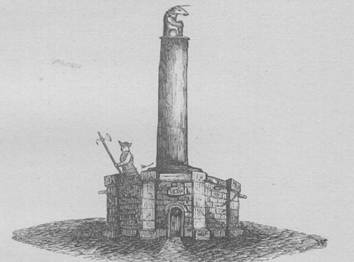
the
tron and customes
are noticed under date 1383. The original Market Cross was probably a
tall stone pillar, erected on the top of a few pyramidal steps
(similar to the Cross re-erected in 1869). In 1620 the original Cross
appears to have become so “dilapidated” that it became dangerous, and
was removed. Then a new one, resembling the Crosses of Edinburgh,
Aberdeen, &c., was erected in the “Hie-Gate,”
opposite the foot of “Croce
Wynde.” This new Cross of 1620 was
a elegant structure. The above
representation of it is taken, in its then “rude and dilapidated
state,” from an old drawing of date 1747, by “J.S.”
This Structure
appears to have been about 10 feet in diameter, as ascertained by the
“wheel-redii” of stones formed in the
causeway in the place where it stood. The small house was octagonal,
12 feet in diameter and about 10 feet in height. From the
centre arose the “pillar-stone” supporting
a unicorn. The whole height of the Cross, including the pillar, would
be about 20 feet. Round the inside of the small building, at the
height of a few feet, there was a stone pavement, which was reached by
a few steps. This stone pavement was the place whereon the town’s
officers stood to read public proclamations, &c.; and on the
“proclaiming the advent of a new Sovereign” the Provost, Magistrates,
&c., ascended to this paved place and made the proclamation. On “the
King’s birth0days the Magistrates and Council stood all round the
pavement and drank the King’s health, and the often threw their
glasses into the air!” The door faced the east. Round the top of the
octagon house there were carved stones. Only one, so far as the
writer knows, exists—viz., the stone above the door-way—having on it
the burgh arms. It is in the possession of writer. The stone is well
authenticated, having come through two hands only when he received it
as a gift. The following is a sketch of the stone.
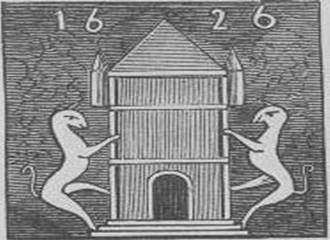
In order to
preserve this stone, the writer intends to have it sunk into some on e
of the steps in front of the recently re-erected Cross. (See the
several notices of the Cross in the Annals between 1620 and 1868.)
THE CROSS WYND
“FIRE-STANE” INSCRIPTIONS.—This house,
already alluded to, occupies the north-west angle of the Cross
Wynd, and stood “contiguous to the Cross
Wynd Port.” The previous house, which
stood on the same site, was destroyed by the great fire, May 25, 1624.
The present
building appears to have been erected or completed in 1626, as
indicated by an old stone which was once on the west wall of the
house. Oh the east wall of this house, in the Cross
Wynd, and about ten feet above the
pavement of the street, there is to be seen a dilapidated stone, about
four feet square, having on it several references from Scripture
regarding the great fire. Perhaps no other town in Scotland possesses
so full and so interesting a memorial of an incident of other days.
Many of the letters on this unique stone are so “time-worn” that it is
impossible now to make them out. In a dew years, none of those left
will be readable. The proprietor should adopt measures to preserve
them. The following engraving represents the present appearance of
the stone, with the exception of the restoration of some of the
worn-out words and letters on it:--
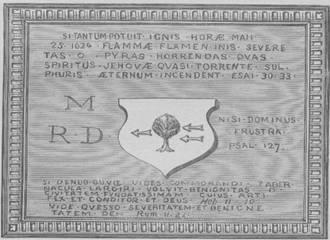
Of which the
following is a free translation:--“Seeing that in so brief a space, on
the 25th May, 1624, so much desolation was caused by a fire
and the fury of the flaming blast, then O
consider the dreadful blazing pyres which the breath of Jehovah, as if
with a torrent of brimstone, will for ever keep in flames.” (Isaiah
xxx. 33.) The initial letters, “M.R.D.,”
and consequently, as was customary at this period, prefixed his
initials with an “M.”
In the
centre of the stone is a shield, having
cut on it in the centre, in alto
relievo, a Tree, and Three Arrows or
Darts, “on the wing”—two on the right-hand side of it, and one on the
left side. Whether the tree is an emblem of “the Tree of Life,” and
the darts, “the fiery dats of the wicked
one,” does not appear clear, but it is likely they will have a
scriptural solution.
“Except the Lord
build the house, they labour in vain that
build it.” (Psalm cxxvii. I.)
Under the shield
the Latin words may be thus rendered:--“Since new tabernacles to dwell
in have, by a bountiful Providence, as you see, been bestowed upon us,
O seek the city which has sure foundations,
whose Builder and Maker is God.” (Heb. xi.
10.)
The last
admonition may be rendered: “I beseech you, behold (in this dire
calamity) the goodness and the severity of God.” (Rom.
xi. 22.)
These inscriptions
are in bas-relief (cut into the stone); the Shield, the Tree, and the
Arrows are in alto.
It was once
supposed that the centre of the Shield was
occupied by a Quiver full of Arrows, which along with the three in
flight, was thought to have some connection
with the 127th Psalm.
About 25 or 30
years ago, during the process of some alterations being made on this
house, three triangular stones were removed from it west wall. No 1
Stone had cut on it a circle floriated, with bar across the
centre. Above the bar were two arrows;
below it, on arrow, with all heads pointing downwards, the initials “I.D..”
mutilated, were in the lower corner angles (John Dury?). No 2 Stone
had on it 1626, and the Latin words—
SVSTINE ABSTINE
1626
VIZ., Bear and
Forbear, showing by the date, “1626” that the house would be finished
in this year. No. 3 Stone has on it—
M. W. D. : A FVNDAMENTO DENVO EXTRVXIT
VIZ., Mr. W.D. built
[this house] anew from the foundation.
These stones,
along with many other “Dunfermline sculptured stones,” were long in
the possession of the late Mr. Joseph Paton,
Wooer’s Alley, Dunfermline. They are now to be seen at the west end
of the Nave of the Abbey Church.
Note.—In the year
1858, while the writer was collecting materials fro an account of “The
Great Fire” for the Dunfermline Journal, he caused search to be made
for all date and motto stones referring to 1624-1628 on houses in
Dunfermline, directing particular attention to The “Cross
Wynd Stane.”
The inscriptions were then copied for him. Since no notice is taken
of this interesting Stone in any “History,” it would seem that the
writer was the first who brought it before the public.
THE ANCIENT “PRÆTORIA,”
OR TOLBOOTH OF THE BURGH.—This building was
probably burnt in 1624. The Burgh Records do not inform us as to
whether or not the Town-house of this period was burnt; but that will
be no surprise to those who know that these Records do not allude to
the fire at all! It is very probable, however, that the “Prætoria”
was burnt, for a house next to it, on the south, and which was
connected with the prison, was destroyed. This house belonged to John
Anderson, and it was rebuilt two years after the first. In 1769, part
of Anderson’s premises were removed to make way for the new Town-house
then erecting. The “lintel-stane” was
used in the new building. This “stane”
was found in the lower part of the west wall, or gable, of the last
Town-house, in 1876, when it was being removed. The following is a
copy of the letters and date on this stone:--
I A 1626
The date belongs to
“the re-building period of the burgh.””
“AULD KIRK”
REPAIRS.—Erection of Lafts,
Buchts, &c.—This year, it was found that
the south-west end of the Church was much out of repair, as also the
roof of the aisle there. The faults were repaired, and the date,
“1626” left in a small circular stone in the
centre of the aisle-roof. At the same time, the Scholars’ and
Sailors’ Lafts appear to have been
erected, and several family buchts, in
other parts of the kirk. (See Dunf.
Parish Rec. &c.)
PROVOST OF
DUNFERMLINE—Thomas Wardlaw, of Logie.
(Burgh Records.)
SLANDERS OF
DUNFERMLINE TO BE PUNISHED.—On the 7th of May , this year,
the Town Council of Dunfermline passed an Act for punishing of those
who “cursed and slandered the town,” wishing it to be burned again.
(See Annals Dunf. date 1651.)
1627.—WITCHES AND
WARLOCKS!—An old MS. extract in the
writer’s possession, notifies that “the wast
o’ fife, specially Dunfermlin and torryburn,
began to be infested be witches and warlocks.” (See
An Dunf. date 1643.)
PENNY
WEDDINGS.—According to an old note, Penny Weddings began to be very “uproris
in Dunfermling: (about 1627 and 1628), and “Sandie
Dempster, the wading fiddler,” took an
active part at them with “playin’ and kickin’
up and dancing.” (See also Annals Dunf. date 1648.)
PROVOST OF
DUNFERMLINE.—Thomas Wardlaw, of Logie.
(Burgh Rec.)
1628.—DUNFERMLINE
REBUILT.—It would appear, from several
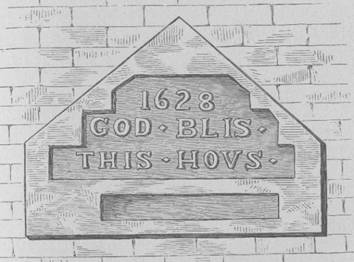
MS.
notes, that “Dunfermline had, by the year
1628, in a great measure recovered itself from the great disaster of
1624;” and that “many of the new erection s were a great improvement
on those destroyed.” Also, it is noted, that “many of the newly-built
houses were decorated with motto and date stanes,”
A few years ago, on the south side of East High Street, “a
fire-motto-date stane” was discovered, of
which the above is a representation. The date on this stone (1628)
refers to the fourth year after the great fire of May 25th,
1624, when the greater part of the town had been rebuilt.
1629.—BURNTISLAND,
and the Communion Expenses.—“1629 24th May,
Dumfarling. This day sent a discharge to
Dumfarmling for the
landwart of the elements celebrat
in our kirk the 5 and 12 of
Appryll this year.” (Burntisland Kirk
Session Records.)
THE WRIGHTS’ LAFT
in the Church of Dunfermline.—The
incorporation of Wrights erected, in 1629, a seat between the two
eastmost pillars, south side of the
kirk. This seat had a fine old oak
carved front, with arms, and the motto—
GOD BLESS
THE JOINERS OF DUNF.
This oak front was
long in the possession of the late Mr. Paton,
and was sold at his sage in November, 1874.
PROVOST OF
DUNFERMLINE.—Thomas Wardlaw, of Logie.
(See Burgh Records.)
1630.—WILLIAM
SCHAW and the Mason Craft.—William (son of William
Schaw, Master of Works to James VI.) and
himself Master of Works to Charles I., granated
a charter to the general lodge, recognizing Sir William Sinclair of
Roslin as patron and protector from age to
age of their craft. This charter is attested by names of deacons and
master of the lodges of several of the Royal burghs in 1630. Among
the signatures appears that of Robert Alisone,
one of the Masters of the Lodge of Dunfermline. (Chal. Hist. Dunf.
vol. ii. p. 156.)
JOHN HENRYSONE,
Notrious Assruit,
who appears to have been the writer of these charters, was, most
likely, the son of John Henrysone, public
notary and schoolmaster of Dunfermline. (See Annals Dunf. date 1573.)
John Burne, one of the Masters of the
Dunfermline lodge, subscribes his name to this charter—the pen being
led by John Henrysone, viz.,--“I, Jon
Burne, ane of
the Mr.s of Dunfermline, wt my hand at ye
pen, led be ye notar
vnder subscrywand for me at my
command, because I can not writ myself.—J.
Henrysone, notorious assruit.”
(Vide Lyon’s Hist. Lodge, Edin. p. 61;
also An. Dunf. date 1598.)
PROVOST OF
DUNFERMLINE.—Thomas Wardlaw was re-elected Provost. (Burgh Records.)
1631.—HENRY
WARDLAW, of Pitreavie (eldest son of Queen Anne’s Chamberlain), was
created a Nova Scotia Baronet by King Charles I. in 1631. (Chal. Hist.
Dunf. vol. i. p. 304. See also Annals,
Appen. S.)
PROVOST OF
DUNFERMLINE.—Thomas Wardlaw, of Logie.
(See Burgh Records.)
1633.—KING CHARLES
I. IN DUNFERMLINE—Creation of Earl and Five Knights.—King Charles I.
during his sojourn in Scotland this year, on July 4th and 5th,
visited Dunfermline, when he, “with great
solemnitie,” created Sir Robert Kerr Earl of
Ancrum, Lord Kerr of
Nisbet, &c., which was proclaimed by the heralds at the open
windows of “the great chamber” of the Palace. Afterwards, the King
dubbed five of his favourites. The King
left Dunfermline of 5th July. (Balf.
An. Scot. vol. i.; Chal. Hist. Dunf. vol.
i. p. 271.) It has been supposed that
Alexander Clark, of Pittencrieff, was one of this
list of knights.
LORD KINLOSS
CREATED EARL OF ELGIN.—Thomas Bruce, third Lord
Kinloss, was this year created Earl of Elgin by King Charles
I. (Chal. Hist. Dunf. vol. i. p. 289.)
KING CHARLES I.
and the Lordship of Dunfermline, Revocations, &c.—The following
extract is from one of the Acts of the Scottish Parliament, held at
Edinburgh, 28th Janyary (cap.
9):--“Item: His Majesty, with consent of the
saids Estaits, revokes,
cansils, annuls, retracts, and rescinds
all and sundrie
infeftments, grants, dispositions, confirmations, and other
rights whatsoever, made by his Majestie
induring his minority, and
lessage to whatsoever person, or
persones in fee, frank, tenement or
otherwise, of the landes, kirks, teinds,
patronages, offices, and others pertaining to the Lordship of
Dunfermling; to the which his Majestie
succeded as only sone
and heire to his Majesties
umquhile, dearest mother
Queene Anna, who was heritably
infeft in the said lordship of Dunfermling,
and siclyke gifts: revokes all gifts,
alienations, dispositions, and other rightes
whatsoever, made by his Majestie, or his
said dearest mother, unlawfully and against the
lawes of the kingdome, of the said
lordship, or any landes, teinds, offices,
kirks, patronages, and others pertaining to the said lordship at any
time preceeding the date hereof: the same
being so found and verified before the ordinary judge, “ &c. (Vide
Act termed the “King’s General Revocation,” Parliament of Charles I.,
Edinburgh, June 28, 1633, cap 9; Murray’s Laws and Acts of Par. vol.
i. p. 533.)
JAMES HALKET OF
PITFIRRANE KNIGHTED.—James Halket, of
Pitfirrane, was knighted this year by
Charles I., at Dalkeith, on 24th
June. (Chal. Hist. Dunf. vol. i. p. 295.)
PROVOST OF
DUNFERMLINE—Thomas Wardlaw, of Logie.
(See Burgh Records.)
1634.—KING CHARLES
I. “Disappoints and Affronts the Earl Rothes
and Lord Lindasy.”—“Earl
Rothes, Sheriff of Fife, and Lord Lindsay,
bailie of the regality of St. Andrews,
understanden that it was the intention of
the of the King to pass through Dunfermline, collected their friends
there, to the number of nearly 2000, on horseback, and in their best
style of equipage, to testify their loyalty to him,” &c. The King,
however, affronted them much by intentionally changing his route. But
conduct of this nature was not uncommon to Charles. (Aitk.
Hist. Scot. vol. iii. p. 403.)
AULD KIRK
PULPIT—An Elegant New one Erected.—An new
pulpit, of oak, was erected in the Auld Kirk this year. It was very
neatly carved with devices. An iron rod projected from the side near
the Pulpit Book-board, and ended in an ornamental iron cup, which held
an hour-glass (a common appendage of these times). On the back of the
pulpit were the words—
“WHO IS SUFFICIENT
FOR THESE THINGS?”
The pulpit was fixed
to the middle north pillar in the Kirk. The two projecting iron rods
that secured the sounding-board are still to be seen. The pulpit is
now a Abbotsford; it was presented by the
heritors to Sir Walter Scott in 1822. (See An. Dunf. date 1822.)
AULD KIRK
SEATING.—A great many new seats and cradles were added to the Kirk
during 1634, and the “Musicians’ Isle” was then repaired. (Kirk
Ses. Rec.)
1635.—THE
WEATHER.—According to an old MS., the “Janyar
of 1635 set in with grate severitie, with
sleet and snaw-storms,
whilk continuity mair
or les until Febuer,” and it seems that
the streets were in some places “breast high in
snaw.” (MS. by “D. W.”)
POPULATION OF THE
BURGH IN 1635.—The burgh having recovered
from the disastrous fire of 1624, a census appears to have been taken
in 1635, when it was estimated that there were about 1850 souls in the
town and suburbs. (MS. by “J.S.”)
FEVER.—A
“malignant fever” raged for some months in the town and different
parts of the parish, “whilk
carryet of not a few.” (MS.
Advoc. Lib. 1635.)
ASPECT OF THE
STREETS IN 1635.—“Wooden fronts above the first stone storey, many of
them projecting; outside stairs, extending to near the middle of the
street; no pavements, and only part of the ‘Hie-gate’
causeway’d.” (MS.)
1636.—THE PARISH
OF ROSYTH was united to the parish of Inverkeithing early this year.
(Inverkeithing Par Rec.)
SCULPTURED STONE,
1636.—This stone is to be seen on the west
wall of a house, “in the open” of the first close east of Randolph
Street (Bardner’s Close, now call “Brown’s
Close). A now nearly
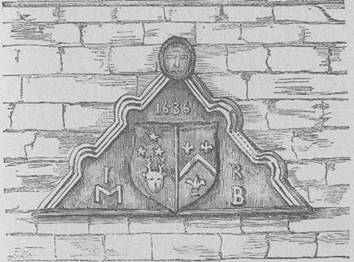
worn-out tradition
informs us, that there formerly stood on the same site the own-mansion
of Lord Callender; that his mansion was
destroyed by the great fire of 25th May, 1624; that the
locality lay long heaped up with debris, and that on the site being
sold in 1634, the present house was built. It will be observed that
the stone is triangular, the top angle terminating in a human face,
under which is the 1636, and below the date there is a plain shield,
which is divided perpendicularly by a bar into equal halves; on the
right-hand half there are three fleur-de-lis—two above, and one below
a cheveron. On the left-hand side are
three five-pointed stars, with a stag’s head and horns below them. On
each side of the lower part (the outside) of the Shield are initial
letters—viz., “I. R.: M. B.”—the whole being enclosed within a waved
ornamental border, formed out of the two sides of the triangular
stone. It is now not known to whom these initials and armorial
bearings refer; but seeing he, the proprietor and builder of 1636, had
a Shield of Arms, he must have been a man of position. By referring
to the “heart-shaped stone” which is over the arch, at the north end
of the same close) the initials “I. R.” will be seen on it. Perhaps
this stone of 1607 and that of 1637 may have been set up by the same
person.
1637.—THE
HERITABLE OFFICES of the Lordship, &c., of Dunfermline conferred on
the Earl of Dunfermline.—Charles, the second Earl of Dunfermline,
obtained a Charter under the Great Seal from King Charles I., for
himself, and as Lord of the Lordship and Regality, conferring upon him
the offices of “Bailiary and
Justiciary of our Lordship and Regality,
on both side of the river and water of Forth excepting what belonged
to the bailiary of Musselburgh.” 24th
April, 1633. (Chal. Hist. Dunf. vol. i.
p. 257.)
ASSISTANT
MINISTERS OF DUNFERMLINE.—At this period, and for some short time
afterwards, there were two assistant ministers In the Kirk of
Dunfermline—viz., Johne
Stanehouse and Samuel Row. (Par. Rec.)
1638.—THE NATIONAL
COVENANT Signed at Dunfermline.—During the
months of March and April, 1638, the National Covenant, as drawn up by
Alexander Henderson and Johnstone of
Warriston, was subscribed this year at
Dunfermline by the nobility, gentlemen, burgesses and community.
Among the signatures are those of the Earl of Dunfermline; Sir Robert
Halkett, of
Pitferrane; James Durie, of
Craigluscar; Robert
Ged (senior and junior), of Baldridge; Henry Wardlaw, of
Pitreavie; William Wardlaw, of Balmule;
and also the then two assistant ministers of Dunfermline,
Johne Stanehouse,
Mr. Samuel Row, &c.; and upwards of 200 other signatures.
We have had in our
possession for several weeks (May, 1878) this National Covenant
document, kindly lent to us by the Kirk Session of Queen Ann Street
Congregation, in whose custody it has been since 1740. The document
consists of a large sheet of parchment 37 ¼ inches by 34 3/4 , on
which is written, in beautiful calligraphy, 74 lines of preliminary
and explanatory remarks. Five of these preliminary lines are as
follow:--
“The Confession of
Faith Subscribed at Dunfermline First by the king’s
Majestie and his Household, in the
zeire of GOD 1580,
Thairefter by persons of all ranks In the
zeire of GOD 1581 by ordinance of the Lords of Secret
Counsall and Acts of
generall Assemblies, Subscribed again be all
Sortes of persons In the
zeire of GOD 1590 by a new Ordinance of
Counsall at the desire of the
Gererall Assemblie
with ane general band for
mentainence of the
trew religion and the King’s person, And now subscribed in the
zeire of GOD 1638 by we Noblemen,
Barronnes, Gentlemen, Burgesses, and
Community under subscribed be and Togidder
with our resolution and promise For the cause
eftir specified, To the Mentainence
of the trew Religion and the King’s
Majestie, According to the Confession
foirsaid, and actes
of parliament, the tenor quhairof
follows.”
The “tenor”
consists of 69 closely-written lines, each 35 1/8 inches in length,
and which, wre they printed along with the
signatures below them, would occupy about 40 pages quarto (same size
as our pages). We must therefore refer the reader to the original
document for further particulars regarding the tenor and the large
number of signatures appended to it (about 250 in number).
The “Confession of
Faith” was, it is said, first in the possession of the Earl of
Dunfermline, or his factor, William Walker, Provost of the burgh.
Afterwards it came into the possession of his descendant, William
Walker, of Rhodes, Clerk of the Regality, who presented it to the Rev.
Ralph Erskine shortly after he became
junior minister of the parish, who is understood to have presented it
to the Session of his newly-formed Secession Church, Queen Ann Street,
about 1740. It is also said that it became the property—after the
Rev. Ralph Erskine’s death, in 1752—of his
son, who gifted it to the Rev. Mr. Fisher, Glasgow, who bequeathed it
a second time to the Queen Ann Street Congregation. (See Chal. Hist.
Dunf. vol. i. p. 273.)
The document, now
time-worn, is enclosed within an oak frame 47 1/4 inches by 44, and is
surrounded by a “gilded flat strip border,” and glazed. This is an
interesting document, and ought to be photographed for sale.
PRESBYTERY OF
DUNFERMLINE, &C.—In the year 1638 the Synod
of Fife was divided into four Presbyteries—viz., St. Andrews.
Cupar, Kirkcaldy, and Dunfermline, which
still continue. (Chal. Hist. Dunf. vol. i.
p. 575.)
MR. SAMUEL ROW was
this year appointed an assistant to Mr. Harry
Makgill. (Parish Records.) Mr. Row was an Irishman, and
assisted Mr. Makgill for some considerable
length of time.
PROVOST OF
DUNFERMLINE—James Reid. (Burgh Records, 1638.) The Provost was an
elder, and was the representative of the Dunfermline Presbytery in
“the famous General Assembly” held at Glasgow in 1638.
THE OFFICE OF
READER of Dunfermline Church abolished. (Burgh
Records, &c.) For the duties of the office of “Reader,” see
Chal. Hist. Dunf. vol. i. pp. 541, 542,
&c.)
REPAIRING OF
ROSYTH CASTLE.—On the stone-bars of windows
in the Castle are the following initials and date:--
T. * S.-------M.
* N. 1639
TWENTY-FIVE
DUNFERMLINE MEN to be Selected for the Wars.—“4th May,
1639.—The whilk day the
proveist, baillies,
and counseill, having
receavit instructions from the Committee of
Warre anent the levying of
twentie fyve
men furth of said
burghe for going to the Southe in
this present expeditione, and for
furnishing of thame during the space
aftirspect, Have for fulfilling
thairof appointit
the said Twentie fyve
men to be leavit and chosen out of the
inhabitants of the said burghe for
marching and going to the border at the Southe
as for suplie to the
armie prsntlie
thairat in this prsnt
expeditione upon
twentie four hours’ advertisement. And ordains the
saids twnetie
fyve men to be
funishit and enterteined upon the
town’s charges during the space tne days
after thair removal
furth fyve men, the
counseill have
electit Mr. Harie
Mackgill, minister, James Reid, provost,
Peter Law, baillie, Mr. Patrick
Auchinleck, John
bennet, Robert Steinsone,
wha are ordainit
to report thair
nominatione and choising of the
said twentie fyve
men to the nixt
counsall day.” (Burhg Records.)
1639.—MARGARET
MOWTRAY ORDERED TO BE PLACED IN THE JUGGS AT THE TRON for deprecating
“ane horrible
Judgement.”—“4th May, 1639:
Thisday the proveist,
baillies, and
counsall convicts Margaret Mowtray
in ane outlaw of aught
punds for calumniating of the
armie that went to
Bruntiland, and for deprecating ane
horrible judgement to befall
thaim. Or othirwayes
to stand on the trone,
inclosit in Jogis
fra this
prsnt moment till aught hours at
nicht.” (Burgh Records, May, 1639.)
A LEVY OF FOUR
HUNDRED POUNDS ON THE BURGH.—“The proveist,
baillies, and
counsall, considering how the common guid
of the burghe is far within and will not
extend to the Sommes of money already
disbursit be thame
to the Souldiers
alreadie sent further in this expeditione
to the northe, and of the
leavie that is going to the
Southe, Have
thairfore for suplie
thairof appointit
and ordainit ane
taxt and stent
of four hundredth punds to be
payit be ye inhabitants of ye said
burghe, accordinglie
as they sall be
stentit to the Stent Masters
appoyntit for that effect, and ordains the
taxt roll yrof
to be prsntlie drawn up.” (Burgh Records,
May, 1639.
TOWN COUNCIL ACT
Relative to Unmannerly Councillors.—“6
May, 1639, the Provost Presiding: The whilk
day, for the represing of the unmannerly
and indecent formes used be sum of the
counselloris of this
burghe, wha,
aftir they are set and inclosed in
the counsel hous to use and
exerces thair
office anent the deciding and concluding of all matters belonging to
their place and functions, with thair
garrulity and much loquacity, trouble and molest the said counsel
unrequirit, that it
seemeth rather ane barbaric court
then ane counsel, not
befeting men of such ane grave
office, It is Statutc and
Ordainit, whatsoever counselor of the said
burghe sall
speak, reason, or give his voice and voit
in Counsell frae
this tyme forth coming
sall pay at that same time
xiis. For ilk
failzure, toties
quoties.” (Burgh Records, May, 1639.)
PROVOST OF
DUNFERMLINE.—James Reid, re-elected Provost. (Burgh Records.)

